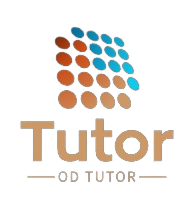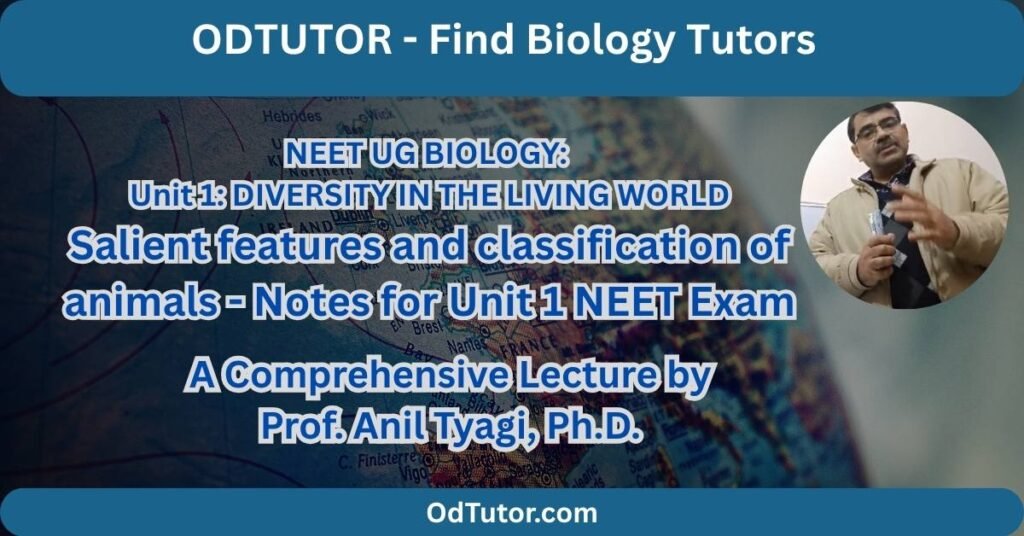My dear NEET aspirants! This is Professor Anil Tyagi. Today, we will embark on a systematic journey through the animal kingdom, a vast and highly logical topic that is a favorite for the NEET UG exam. Classifying animals is not about memorizing a list; it is about understanding the evolutionary ladder, where each rung represents a new, complex adaptation. We will classify non-chordates up to the phyla level and chordates up to the class level, focusing on the salient features that distinguish each group. Let’s begin.
NEET UG BIOLOGY: ANIMAL KINGDOM
Unit: Salient Features and Classification of Animals
A Comprehensive Lecture by Prof. Anil Tyagi, Ph.D.
Welcome, future doctors. A thorough understanding of animal classification is paramount. It forms the basis for comparative anatomy, physiology, and embryology—subjects crucial for your medical career. The system we will study is based on fundamental body design and complexity. We will follow a logical path, starting from the simplest animals with loose cell organization to the most complex vertebrates. Remember, we classify organisms based on key characteristics: Symmetry, Germ Layers, Coelom, Notochord, and Body Plan.
Part 1: Basis of Classification
Before we dive into the phyla, let’s solidify the concepts that define them:
- Symmetry:
- Asymmetrical: Cannot be divided into two identical halves (e.g., Sponges).
- Radial Symmetry: Body can be divided into two identical halves by any plane passing through the central axis (e.g., Cnidarians).
- Bilateral Symmetry: Body can be divided into two identical left and right halves only by one specific plane (e.g., Annelids to Chordates).
- Germ Layers: Layers in the embryo that give rise to all tissues and organs.
- Diploblastic: Two layers – Ectoderm (outer) and Endoderm (inner). A jelly-like mesoglea is present in between (e.g., Cnidarians).
- Triploblastic: Three layers – Ectoderm, Mesoderm (middle), and Endoderm (e.g., Platyhelminthes to Chordates).
- Coelom (Body Cavity): The cavity between the body wall and the gut wall, lined by mesoderm.
- Acoelomate: No coelom (e.g., Platyhelminthes).
- Pseudocoelomate: Coelom is not lined by mesoderm (e.g., Aschelminthes).
- Coelomate: True coelom present, lined by mesoderm (e.g., Annelids to Chordates).
- Notochord: A rod-like, flexible structure made of vacuolated cells, present at some stage of life. It is the defining feature of Phylum Chordata.
Part 2: Classification of Non-Chordates (Invertebrates)
Non-chordates are animals that do not possess a notochord. They represent over 95% of the animal kingdom.
1. Phylum Porifera
- Salient Features:
- Common Name: Sponges.
- Habitat: Exclusively aquatic, mostly marine.
- Body: Asymmetrical. Body has numerous pores (ostia) for water inflow and one large opening (osculum) for outflow.
- Cellular Level of Organisation: Cells are loosely arranged and do not form proper tissues.
- Skeleton: Internal skeleton made of spicules (calcareous/siliceous) or spongin fibres.
- Digestion: Intracellular.
- Reproduction: Both asexual (budding, gemmules) and sexual.
- Examples: Sycon (Scypha), Euplectella (Venus’ flower basket), Spongilla (Freshwater sponge).
2. Phylum Coelenterata (Cnidaria)
- Salient Features:
- Common Name: Jellyfish, Sea Anemones, Corals.
- Habitat: Exclusively aquatic, mostly marine.
- Body: Radially symmetrical and diploblastic.
- Tissue Level of Organisation.
- Cnidoblasts: The defining feature. These are stinging cells containing capsules (nematocysts) used for defence and capturing prey.
- Body Forms: Two basic forms: polyp (sedentary, e.g., Hydra) and medusa (free-swimming, e.g., Jellyfish).
- Digestion: Extracellular and intracellular. They have a blind sac body plan (incomplete digestive system with a single opening).
- Examples: Hydra, Physalia (Portuguese man-of-war), Aurelia (Jellyfish), Adamsia (Sea Anemone).
3. Phylum Ctenophora
- Salient Features:
- Common Name: Comb jellies or Sea walnuts.
- Habitat: Exclusively marine.
- Body: Radially symmetrical, diploblastic.
- Locomotion: Eight external rows of ciliary comb plates.
- Digestion: Complete digestive system (mouth and anal pores).
- Special Feature: Bioluminescence.
- Examples: Pleurobrachia, Ctenoplana.
4. Phylum Platyhelminthes
- Salient Features:
- Common Name: Flatworms.
- Body: Bilaterally symmetrical, triploblastic, and acoelomate.
- Body Plan: Flattened body; blind sac body plan.
- Organ Level of Organisation.
- Habitat: Mostly parasitic, some free-living.
- Special Feature: Hermaphrodite (monoecious).
- Examples:
- Free-living: Planaria (has high regeneration capacity).
- Parasitic: Taenia solium (Tapeworm), Fasciola (Liver fluke).
5. Phylum Aschelminthes (Nematoda)
- Salient Features:
- Common Name: Roundworms.
- Body: Bilaterally symmetrical, triploblastic, and pseudocoelomate.
- Body Plan: Cylindrical body; tube-within-a-tube (complete digestive system with mouth and anus).
- Organ System Level of Organisation.
- Reproduction: Dioecious (unisexual), often with sexual dimorphism (females are longer).
- Examples: Ascaris lumbricoides (Roundworm), Wuchereria bancrofti (Filarial worm), Ancylostoma (Hookworm).
6. Phylum Annelida
- Salient Features:
- Common Name: Segmented worms.
- Body: Bilaterally symmetrical, triploblastic, and coelomate.
- Metameric Segmentation: The body is divided into segments (metameres). This is a key evolutionary advancement.
- Locomotion: Possess longitudinal and circular muscles. Many have chitinous bristles called setae.
- Circulation: Closed circulatory system (a major feature).
- Examples: Pheretima (Earthworm), Nereis (Sandworm/Clamworm), Hirudinaria (Leech).
7. Phylum Arthropoda
- Salient Features:
- Common Name: Insects, Crustaceans, Spiders, etc. (Largest phylum in the animal kingdom).
- Body: Bilaterally symmetrical, triploblastic, and coelomate.
- Exoskeleton: Body is covered by a chitinous exoskeleton.
- Body Plan: Body is divided into head, thorax, and abdomen, and has jointed appendages (arthropod means “jointed legs”).
- Circulation: Open circulatory system (blood is pumped into body cavities called haemocoel).
- Respiration: Through gills, book gills, book lungs, or tracheal system.
- Examples:
- Class Insecta: Apis (Honey bee), Anopheles (Mosquito).
- Class Crustacea: Cancer (Crab), Palinurus (Lobster).
- Class Arachnida: Palamneus (Scorpion), Araneae (Spider).
- Class Myriapoda: Scolopendra (Centipede).
8. Phylum Mollusca
- Salient Features:
- Common Name: Snails, Mussels, Octopus.
- Body: Bilaterally symmetrical, triploblastic, and coelomate.
- Body Plan: Body is soft, divided into a head, a ventral muscular foot, and a dorsal visceral hump. The hump is covered by a calcareous shell.
- Respiration & Gaseous Exchange: By gills (ctenidia).
- Special Feature: A rasping, tongue-like organ called radula for feeding.
- Examples: Pila (Apple snail), Pinctada (Pearl oyster), Sepia (Cuttlefish), Octopus (Devilfish).
9. Phylum Echinodermata
- Salient Features:
- Common Name: Starfish, Sea urchins.
- Habitat: Exclusively marine.
- Symmetry: Adults are radially symmetrical, but larvae are bilaterally symmetrical.
- Body: Triploblastic and coelomate.
- Endoskeleton: Made of calcareous ossicles or spines.
- Water Vascular System: A unique system of tube feet used for locomotion, capture of food, and respiration.
- Examples: Asterias (Starfish), Echinus (Sea urchin), Antedon (Sea lily), Cucumaria (Sea cucumber).
Part 3: Classification of Chordates
Chordates are characterized by the presence of a notochord, a dorsal hollow nerve cord, and paired pharyngeal gill slits at some stage of their life cycle.
Subphylum 1: Protochordata (Acraniata)
- Salient Features: They are marine, primitive chordates with a notochord present only in the larval tail or throughout life, but they lack a head (cranium).
- Examples:
- Urochordata: Ascidia (Sea squirt) – notochord only in larval tail.
- Cephalochordata: Branchiostoma (Amphioxus or Lancelet) – notochord extends from head to tail and persists throughout life.
Subphylum 2: Vertebrata (Craniata)
Animals with a true vertebral column and a well-developed head (brain box or cranium).
A. Superclass: Agnatha (Jawless Vertebrates)
- Class: Cyclostomata
- Salient Features:
- Jaws: Absent. They have a circular, sucking mouth.
- Habitat: They are ectoparasites on some fishes.
- Body: Elongated, eel-like body.
- Skeleton: Cartilaginous.
- Habitat: Marine but migrate to freshwater for spawning (anadromous migration).
- Examples: Petromyzon (Lamprey), Myxine (Hagfish).
- Salient Features:
B. Superclass: Gnathostomata (Jawed Vertebrates)
This superclass is divided into two major groups based on the nature of the endoskeleton.
I. Pisces (Poikilotherms/Cold-blooded, Aquatic)
- Class 1: Chondrichthyes
- Salient Features:
- Skeleton: Cartilaginous.
- Body: Streamlined body, ventral mouth.
- Gills: Gill slits are separate and without an operculum.
- Scales: Placoid scales (tooth-like).
- Fertilization: Internal. Many are viviparous.
- Examples: Scoliodon (Dogfish), Pristis (Sawfish), Torpedo (Electric ray).
- Salient Features:
- Class 2: Osteichthyes
- Salient Features:
- Skeleton: Bony.
- Gills: Gills are covered by an operculum.
- Scales: Cycloid or ctenoid scales.
- Fertilization: Usually external. They are mostly oviparous.
- Special Feature: Presence of an air bladder for buoyancy.
- Examples:
- Marine: Hippocampus (Sea horse), Exocoetus (Flying fish).
- Freshwater: Labeo (Rohu), Catla (Katla).
- Salient Features:
II. Tetrapoda (Four limbs, adapted for land life)
- Class 1: Amphibia
- Salient Features:
- Habitat: Can live both in water and on land.
- Skin: Moist, smooth, and without scales.
- Respiration: Through gills, lungs, or skin.
- Heart: Three-chambered.
- Fertilization: Mostly external. They are oviparous.
- Examples: Rana (Frog), Bufo (Toad), Salamandra (Salamander).
- Salient Features:
- Class 2: Reptilia
- Salient Features:
- Habitat: Mostly terrestrial.
- Skin: Dry, with epidermal scales or scutes.
- Respiration: Through lungs only.
- Heart: Incomplete four-chambered (except crocodiles which have a complete four-chambered heart).
- Fertilization: Internal. They are oviparous.
- Examples: Chameleon, Calotes (Garden lizard), Naja (Cobra), Chelone (Turtle), Crocodilus (Crocodile).
- Salient Features:
- Class 3: Aves (Birds)
- Salient Features:
- Body: Streamlined, covered with feathers. Forelimbs modified into wings.
- Bones: Pneumatic (hollow, filled with air) to aid in flight.
- Respiration: Lungs are connected to air sacs for more efficient respiration.
- Heart: Complete four-chambered.
- Fertilization: Internal. They are oviparous.
- Examples: Columba (Pigeon), Psittacula (Parrot), Pavo (Peacock).
- Salient Features:
- Class 4: Mammalia
- Salient Features:
- Skin: Has hair. Presence of mammary glands to nourish young ones.
- Respiration: Through lungs.
- Heart: Complete four-chambered.
- Special Feature: Presence of a muscular diaphragm.
- Fertilization: Internal. Most are viviparous (except platypus and echidna which are oviparous).
- Examples: Rattus (Rat), Canis (Dog), Felis (Cat), Homo sapiens (Human), Macropus (Kangaroo), Ornithorhynchus (Platypus).
- Salient Features:
Professor Tyagi’s Key Takeaways for NEET Success:
- Focus on Distinguishing Features: For Non-Chordates, remember the sequence: Porifera (pores, cellular) → Coelenterata (cnidoblasts, tissue) → Platyhelminthes (flat, acoelomate) → Aschelminthes (round, pseudocoelomate) → Annelida (segmented, coelomate) → Arthropoda (jointed legs, exoskeleton) → Mollusca (soft, muscular foot) → Echinodermata (radial, water vascular system).
- The Chordate Triad: For any animal to be a chordate, it must have a notochord, dorsal hollow nerve cord, and pharyngeal gill slits at some stage.
- Heart Chambers are Key: Amphibia (3), Reptilia (Incomplete 4), Aves & Mammalia (Complete 4). This is a high-yield point.
- Fertilization & Development: Know which groups are oviparous (egg-laying) and which are viviparous (live-bearing).
- Examples are Non-Negotiable: Memorize the scientific names of the common examples provided, as direct questions are frequently asked.
By building this hierarchical structure in your mind, you can tackle any classification question with confidence.
Your mastery of this systematic approach will undoubtedly pay rich dividends on your NEET paper. Stay focused!
– Prof. Anil Tyagi

